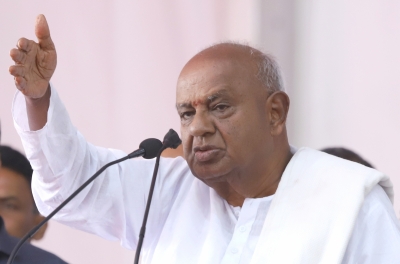By Nirendra DevNew Delhi, June 3 : Is it possible to say that ‘mistakes’ by former Prime Minister I.K.Gujral and Communist leader Indrajit Gupta — incidentally both deceased — have created today’s ‘mess’ in Naga peace parleys?
Around 1998-99, at one point even L.K.Advani as Atal Bihari Vajpayee’s Home Minister was stunned to note that unlike his predecessor H.D.Deve Gowda, Gujral never met the NSCN-IM leaders.
But the ceasefire initially only for six months was announced between NSCN-IM and the government in July-August 1997 when Gujral was the Prime Minister.
The announcement made on July 25, 1997 in the Parliament came into effect from August 1.
Could a suave and expert hand in foreign policy — famous for his ‘Gujral doctrine’ — commit such a lapse or was it one of those oversights? Gujral admitted certain things were secret and certain things were not discussed.
Army officials said the truce was confined to the state of Nagaland only.The then Nagaland Chief Minister, S.C.Jamir, addressed the media shortly after Gujral spoke in the Parliament, but he too had no details.
In 1998-99, when the Vajpayee government was in power, senior officials used to often say that one big demerit of the 1997 Naga ceasefire was that it “lacked clear definition”.
One senior official had said: “There were no written terms and conditions and it was merely an understanding.”
Today, that confusion has actually opened a Pandora’s Box.The NSCN-IM militants are negotiating for peace and at the same time they want a separate flag and a Naga Constitution.
Curiously again, no government after Gujral’s thought it would be wise to review the clauses of the initial agreement.
On October 17, 2020, former Mizoram Governor Swaraj Kaushal had said, “The symbols of sovereignty namely, separate constitution, flag, currency, defence and foreign affairs are sacrosanct and never negotiable.”
Kaushal was also one of the interlocutors in Naga peace matters around 1998 when Vajpayee became the Prime Minister for the second term.
While one talks of the Naga peace parleys having started under two United Front Prime Ministers, Deve Gowda and Gujral, we tend to forget that under both the PMs, comrade Indrajit Gupta was the Home Minister.
A hardcore Communist, Gupta did not have the administrative pulse in his grip always.Babus were trusted and given ‘extra powers’.
K.Padmanabhaiah as the Home Secretary belonged to that period.Of course, he became an interlocutor in the peace parleys under the Vajpayee government and allegedly even declined to visit Nagaland.
His favourite meeting place(s) allegedly used to be Bangkok or even Paris and Zurich in Europe.
Deve Gowda had met two NSCN-IM leaders formally at Zurich in February 1997.
Both Deve Gowda and Gujral must have got their hands in so many other challenges and hence the Naga peace talks were left to the Home Ministry and some senior officials.
As the in-charge of the Home Ministry (MHA), in retrospect, it is being argued today that Indrajit Gupta should have done his part well.The homework was ignored.
When members in the Parliament and outside it sought ‘more details’ on the ceasefire from Prime Minister Gujral, they were requested not to press for it.Whatever was agreed in writing then and the so-called Competencies to the Framework Agreement inked in 2015 (during PM Narendra Modi’s tenure) have been kept under the carpet.
As a result of this, even the Core Committee of Nagaland MLAs and ministers and elected Chief Minister Neiphiu Rio are not aware of the details of the parleys between NSCN-IM and the Centre even today.
Sources close to Chief Minister Rio said, “Yes, the Chief Minister does not have the details.These have made things difficult at times.”
Naga intellectuals and even voluntary organisations are annoyed over this ‘lack of transparency’.
“Our stand and deal is open and transparent.The status paper is clear.
The NNPG had to steer through the precipitates strewn out from the protracted long years of peace talks.The Government of India also hardened its stand at times.
It was a tough task to bring matters on plane where both sides, the Nagas and the Government of India, have equal stance and position,” said NNPG convener N.Kitovi Zhimomi.
This umbrella organisation is not insisting on flag and Constitution, saying all such issues can be discussed later as what is of paramount importance now is peace and an early solution.
But in the event of perceived ‘secrecy’ in talks between the NSCN-IM and the Centre, even the NNPG and some Naga intellectuals and retired civil servants are confused and also unhappy.
Retired IAS officer Khekiye K.Sema wrote in an angry piece in a local newspaper that the NSCN-IM led by Thuingaleng Muivah is “spearheading the negotiation with the government and trying to decide the fate of the Nagas of Nagaland without letting us know exactly what our future is going to look like”.
The NNPG had said in a statement last week that the NSCN-IM leaders are “extorting our people and utilising much of Nagaland’s money to buy and develop farmlands in Dimapur, Chumukedima and Peren districts”.
It said mansions have come up in Ukhrul, in other parts of India and also abroad.
“With such grandiose luxury accumulated over three decades, it is very easy to hide behind powerful slogans like greater Nagalim, flag, Constitution etc.to soak in the wealth of Nagaland for a few more decades,” NNPG said.
All these now have raised other sorts of concerns.Neutral observers in Dimapur and Kohima – government servants and businesspeople – say things are moving towards possibilities of some ‘communal feuds’ and media war and blame game have become the order of the day.
The locals-outsiders angle has a dangerous connotation in the northeast and in states like Nagaland.
If this is not stopped at this juncture, things may become uncontrollable.
Various other organisations have also expressed similar concerns.
In a statement, the Ao Students’ Conference of a major and highly-educated tribe said: “For decades, Naga citizens have quietly endured extortion of national workers, but we have been denied the Naga solution.For how long will the Naga citizens be kept in the dark?”
But all these take us back to 1997.Statesmanship demanded that leaders like Deve Gowda, Gujral and Indrajit Gupta had envisioned all these.
The present situation is a baby of the past.But with regard to Naga talks, may be the day is not far when the United Front dispensation — led by two Prime Ministers, supported from outside, ostensibly only to prevent the BJP from coming to power, may have to shoulder some blame.
The Naga hills need not burn again.
(Nirendra Dev is a New Delhi-based journalist.
He is also the author of the book ‘The Talking Guns: North East India’.The views expressed are personal)
arm/
#Deve #Gowda #Gujral #Indrajit #Gupta #mess #Delhi #Ajit #Hari #Delhi #New Delhi #Mizoram #Nagaland #Kohima #Kohima #Paris #Bangkok #Review #Narendra #Comrade
.






